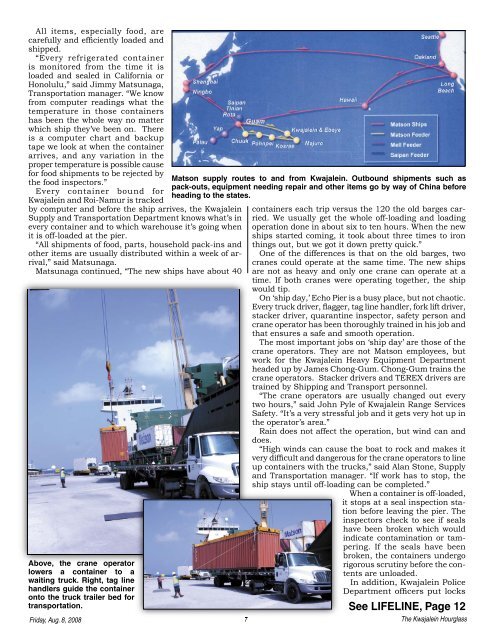An empty container is loaded onto the Matson ship July 30. The ship ...
An empty container is loaded onto the Matson ship July 30. The ship ...
An empty container is loaded onto the Matson ship July 30. The ship ...
Create successful ePaper yourself
Turn your PDF publications into a flip-book with our unique Google optimized e-Paper software.
All items, especially food, are<br />
carefully and effi ciently <strong>loaded</strong> and<br />
<strong>ship</strong>ped.<br />
“Every refrigerated <strong>container</strong><br />
<strong>is</strong> monitored from <strong>the</strong> time it <strong>is</strong><br />
<strong>loaded</strong> and sealed in California or<br />
Honolulu,” said Jimmy Matsunaga,<br />
Transportation manager. “We know<br />
from computer readings what <strong>the</strong><br />
temperature in those <strong>container</strong>s<br />
has been <strong>the</strong> whole way no matter<br />
which <strong>ship</strong> <strong>the</strong>y’ve been on. <strong>The</strong>re<br />
<strong>is</strong> a computer chart and backup<br />
tape we look at when <strong>the</strong> <strong>container</strong><br />
arrives, and any variation in <strong>the</strong><br />
proper temperature <strong>is</strong> possible cause<br />
for food <strong>ship</strong>ments to be rejected by<br />
<strong>the</strong> food inspectors.”<br />
Every <strong>container</strong> bound for<br />
Kwajalein and Roi-Namur <strong>is</strong> tracked<br />
by computer and before <strong>the</strong> <strong>ship</strong> arrives, <strong>the</strong> Kwajalein<br />
Supply and Transportation Department knows what’s in<br />
every <strong>container</strong> and to which warehouse it’s going when<br />
it <strong>is</strong> off-<strong>loaded</strong> at <strong>the</strong> pier.<br />
“All <strong>ship</strong>ments of food, parts, household pack-ins and<br />
o<strong>the</strong>r items are usually d<strong>is</strong>tributed within a week of arrival,”<br />
said Matsunaga.<br />
Matsunaga continued, “<strong>The</strong> new <strong>ship</strong>s have about 40<br />
Above, <strong>the</strong> crane operator<br />
lowers a <strong>container</strong> to a<br />
waiting truck. Right, tag line<br />
handlers guide <strong>the</strong> <strong>container</strong><br />
<strong>onto</strong> <strong>the</strong> truck trailer bed for<br />
transportation.<br />
Friday, Aug. 8, 2008 7<br />
<strong>Matson</strong> supply routes to and from Kwajalein. Outbound <strong>ship</strong>ments such as<br />
pack-outs, equipment needing repair and o<strong>the</strong>r items go by way of China before<br />
heading to <strong>the</strong> states.<br />
<strong>container</strong>s each trip versus <strong>the</strong> 120 <strong>the</strong> old barges carried.<br />
We usually get <strong>the</strong> whole off-loading and loading<br />
operation done in about six to ten hours. When <strong>the</strong> new<br />
<strong>ship</strong>s started coming, it took about three times to iron<br />
things out, but we got it down pretty quick.”<br />
One of <strong>the</strong> differences <strong>is</strong> that on <strong>the</strong> old barges, two<br />
cranes could operate at <strong>the</strong> same time. <strong>The</strong> new <strong>ship</strong>s<br />
are not as heavy and only one crane can operate at a<br />
time. If both cranes were operating toge<strong>the</strong>r, <strong>the</strong> <strong>ship</strong><br />
would tip.<br />
On ‘<strong>ship</strong> day,’ Echo Pier <strong>is</strong> a busy place, but not chaotic.<br />
Every truck driver, fl agger, tag line handler, fork lift driver,<br />
stacker driver, quarantine inspector, safety person and<br />
crane operator has been thoroughly trained in h<strong>is</strong> job and<br />
that ensures a safe and smooth operation.<br />
<strong>The</strong> most important jobs on ‘<strong>ship</strong> day’ are those of <strong>the</strong><br />
crane operators. <strong>The</strong>y are not <strong>Matson</strong> employees, but<br />
work for <strong>the</strong> Kwajalein Heavy Equipment Department<br />
headed up by James Chong-Gum. Chong-Gum trains <strong>the</strong><br />
crane operators. Stacker drivers and TEREX drivers are<br />
trained by Shipping and Transport personnel.<br />
“<strong>The</strong> crane operators are usually changed out every<br />
two hours,” said John Pyle of Kwajalein Range Services<br />
Safety. “It’s a very stressful job and it gets very hot up in<br />
<strong>the</strong> operator’s area.”<br />
Rain does not affect <strong>the</strong> operation, but wind can and<br />
does.<br />
“High winds can cause <strong>the</strong> boat to rock and makes it<br />
very diffi cult and dangerous for <strong>the</strong> crane operators to line<br />
up <strong>container</strong>s with <strong>the</strong> trucks,” said Alan Stone, Supply<br />
and Transportation manager. “If work has to stop, <strong>the</strong><br />
<strong>ship</strong> stays until off-loading can be completed.”<br />
When a <strong>container</strong> <strong>is</strong> off-<strong>loaded</strong>,<br />
it stops at a seal inspection station<br />
before leaving <strong>the</strong> pier. <strong>The</strong><br />
inspectors check to see if seals<br />
have been broken which would<br />
indicate contamination or tampering.<br />
If <strong>the</strong> seals have been<br />
broken, <strong>the</strong> <strong>container</strong>s undergo<br />
rigorous scrutiny before <strong>the</strong> contents<br />
are un<strong>loaded</strong>.<br />
In addition, Kwajalein Police<br />
Department offi cers put locks<br />
See LIFELINE, Page 12<br />
<strong>The</strong> Kwajalein Hourglass

















